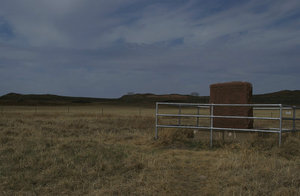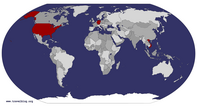Advertisement
Published: April 26th 2013

 ADOBE WALLS
ADOBE WALLS
Find your way to Stinnett, TX then go north until you come to County Road F. Turn right and proceed eastward until you are sure you are lost. Keep going. The site is in the breaks of the Canadian River. Part of that road is clay. If it has been raining be careful. That clay is apt to blind your tires. The road was not rutted though so maybe it never rains there.DAY FOUR: APRIL 25, 2013
People in Texas are the world’s most notorious bullshitters. I got talking to one of them yesterday in Dumas and I’ll be damned if he didn’t invite me to a Bible study. Told me I could get some free grub there maybe. I politely declined the offer because I had church cooking before. It got me wondering what people do in small town America though. Some of them probably join a bowling league; some probably enjoy a good brisk pinochle or whist tournament if it doesn’t get too bloody. Some of them might attend a Bible study twice a week or so. Mostly I thought small town America just stays drunk. Two different people in Dumas told me yesterday that the 287 Roadhouse was fine place to eat. It was right across the street from the Days Inn beside a Valero gas station. I thought it would be convenient to drop by for breakfast about 730 then get some Valero gas before heading out of town. When I got inside the 287 it was clear full of big old North Texas boys already getting hammered before work. Waitress brought me

 BILLY DIXON GRAVE
BILLY DIXON GRAVE
If Billy's grave is at the spot he fired that game winning shot from and oriented in the correct direction you can look a the ridgeline and get an idea o the distance.over a menu, but it was just for lunch and dinner. Breakfast was not taken seriously there at all. Much as I appreciate a little community that never stops drinking I appreciate a modest breakfast just the same. Up the street is a little place called Arnold’s Café. Everyone in there was 80 years old except for the waitress, and me. She was just 75, and I ain’t but 64. All of the old codgers in town collect at one table every morning. There is another table where all of the old ladies gather together each morning. Each table pointedly ignores the other table. They aren’t stingy with their ham in that place, but I don’t think they have it every day. After breakfast I went down to the Valero for my gasoline. That station had 8 pumps and 7 of them were out of order. Finally found some other gas that was two cents cheaper. This has been a busy day. I have come to roost at the AmericInn in Sayre, OK after a drive of 239.7 miles. There are two kinds of restaurants that I dislike in any town. One is a McDonalds and the other is a

 HIDE TOWN
HIDE TOWN
Hide Town was on the Sweetwater River to south of the cemetery. It eventually moved to higher ground and began calling itself Sweetwater City. That name did not fly with the post office because already there were too many places called Sweetwater. They decided to rename their community Mobeetie which was an Indian word for Sweet Water. There is some disagreement n that term. It might mean "I have a small penis".damned old Dennys: hak-phewee. Sayre has both and none other. The motel has a little place that serves beer and wine and you can get an 8 inch store bought pizza for $5. I got a Michelob Ultra for $3.14. The premium beers like Budweiser go for $5.23. The same girl ran the front desk, cooked the pizza, served the beer, inventoried the bar stock and was doing the motel laundry. Her boss pays her $8.50 per hour for doing all five jobs. She ought to put in her application over at McDonalds. They will pay two dollars more and provide benefits. Maybe she ought to move over to Okie City. I felt so bad for her that I gave her a $1.86 tip. Probably she is the owner.
Adobe Walls In the 1840s William and Charles were running a trading post on the Arkansas River in Southern Colorado. They persuaded a few Cheyenne to trade with them. Those who did became the Southern Cheyenne. Black Kettle and Dull Knife were principal leaders among those people. As time bounced along and commerce along the Mountain Route of the Santa Fe Trail increased
the Bents prospered. Charles Bent was appointed Governor of New Mexico in 1846 by General Kearney when he proclaimed that New Mexico was no longer a part of Mexico. Charles was killed by Pueblo Indians during the Taos Uprising in 1847, but William kept on making money hand over fist trading with wild Indians. He had become half wild himself by then. William decided to expand his operation to the Canadian River and built a new trading post there. Trade was not too lucrative though and the outpost was abandoned. It became known as Adobe Walls because the roofs had caved in. There were two major Indian battles fought there. The first battle occurred in 1864 as a response to increased depredation by Plains Indians on white settlements when the soldiers disappeared to go fight in the War Between the States. Kit Carson led some of his battle hardened New Mexico Militia against a much larger group of Comanche, Kiowa and Cheyenne fighters. It was a sharp engagement and Carson’s men had inflicted enough damage that they were allowed to retreat without further hostilities. The buffalo slaughter began in earnest on the southern plains shortly after the War Between the

 MOLLIE BRENNAN
MOLLIE BRENNAN
Bless her heart. She was a girl that men fought and died for.States ended. By 1872 merchants in Dodge City had built a new trading post at Adobe Walls to serve buffalo hunters. In 1874 twenty-nine hunters were trapped at the new Adobe Walls outpost by several hundred enraged and starving Comanche and Cheyenne. Those hunters were handy marksmen and mostly war veterans with plenty of hard bark. The hunters probably would have eventually been slaughtered and their hides taken too had not Billy Dixon taken careful aim and dropped an Indian chieftain from such astonishing range that the rest of the Indians decided it was bad medicine and scampered off in the brush. That was such a legendary shot that folks are still arguing about how far it was, some claim it was a wild shot that happened to kill the chieftain who was actually behind a hill. In any event Billy Dixon died a hero in 1913 and is buried at Adobe Walls. There is nothing left there now but a couple of monuments and lots of history. Bat Masterson fought in that second battle.
Hide Town Adobe Walls was not the only fight Bat was in. By the end of 1875

 BLACK KETTLE
BLACK KETTLE
From Sayre go north to Cheyenne. Turn left on to Hwy 47 and go to the National Park Service Visitor Center. The battlefield is a mile or so to the east. Black Kettle's encampment was in this meadow.Bat was taking his leisure at a hide camp on the Sweetwater River. It was a shipping point for buffalo hides that featured a trading post and saloon and some amazingly talented dancing girls. It was a rowdy sort of place. Nearby was Fort Elliott, named for Major Joel Elliot, who was a casualty of Custer’s battle on the Washita. The soldiers were rowdy and sometimes did not play well with the buffalo hunters at Hide Town. In January of 1876 Bat was in the midst of charming a dancing girl named Mollie Brennan when some soldiers came through the door looking to dance a little themselves. Their sergeant was a fearsome devil and Mollie was terrified of him. Through bitter experience she knew he was a brutally clumsy dancer. The confrontation turned in to gunplay. Bat was wounded in the leg and needed to use a walking stick for any further dancing he did until the end of his peaceful days. He did kill the sergeant in that fight, but unfortunately the sergeant killed Mollie. She was the first occupant of the cemetery in what would eventually become the colorful little community of Mobeetie.
<strong style="mso-bidi-font-weight:

 CUSTER
CUSTER
The red hills in the background are where Custer's men hunkered down in the snow before moving in their attack positions. There were hostile bands Arapaho and Comanche camped nearby but the Osage Scouts wanted Cheyenne blood.normal;">
Washita The Army was sick and bloody tired of Indian attacks on white settlements by 1868. The 7
th cavalry commanded by Lt Col George Armstrong Custer was transferred out to Fort Supply and ordered to begin a winter campaign against any hostiles they could find. With them were a group of Osage scouts who were glad to help because they too were sick and bloody tired of being attacked by those same enemies. The weather was fiercely cold and had been snowing on November 25 when the Osage scouts located a band of Cheyenne on the Washita River. During the night Custer surrounded the sleeping camp and at daybreak he launched an attack as the regimental band launched into Garry Owen. It was a brutal attack on the peace chief Black Kettle’s band. Black Kettle had recently returned from Washington DC where he met President Grant, was given a medal and a flag, and had the assurance that he would not be attacked by soldiers as long as he remained at peace. Black Kettle was killed that day along with his wife, Medicine Woman. Many peaceful Indians were killed that day, 53 were captured and taken to

 ALLISON
ALLISON
I did not see a single gin mill in this whole town. Maybe they just drink on the job. It would save time.Fort Hays, a few escaped. Camped nearby were several other camps that were less peaceful then Black Kettle. Some Arapaho heard the shooting and rushed to help. They cut off a detail lead by Major Joel Elliot and killed every man. Major Elliot was Custer’s second in command and a very popular officer. Custer destroyed the village and the horse herd and was well aware that there were other hostiles grouping nearby. He decided not to risk other men in an effort to locate Elliott and simply rode off with his captives. When he abandoned those men at Washita it caused a divisive split in command of the 7
th Cavalry officers thereafter. Another man killed that day was named Captain Hamilton. He was Alexander Hamilton’s grandson.
Allison I passed through a little place today on the way to Washita called Allison, TX. It is very near, but just south of the Hemphill County line. Clay Allison and his brother briefly operated a ranch in Hemphill County shortly after the War Between the States ended and the Allison Brothers moved to New Mexico. I suspect that the town may have been named in honor of Clay or his brother. If so it would not surprise me to learn that the good people of Allison start out their work day by getting drunk too. Clay was famously fond of the bottle.
Advertisement
Tot: 0.394s; Tpl: 0.012s; cc: 12; qc: 44; dbt: 0.2665s; 1; m:domysql w:travelblog (10.17.0.13); sld: 1;
; mem: 1.1mb










